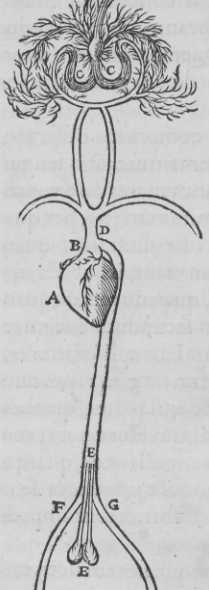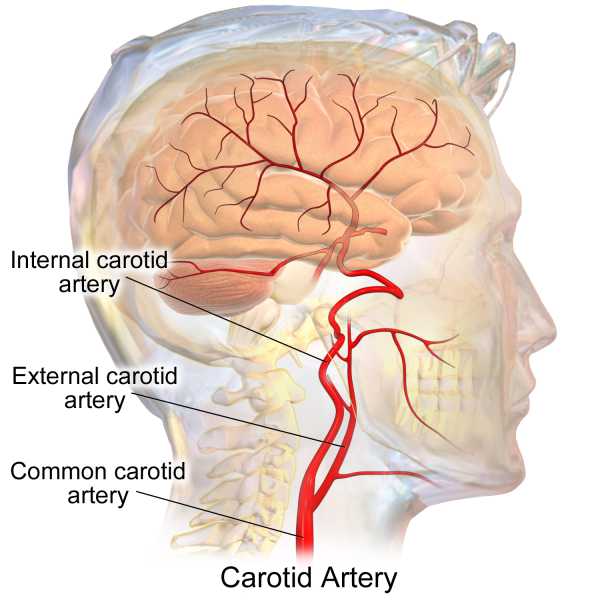How the Blood is Converted into Animal Spirits
Table of Contents
10. Only the blood that enters the brain are stronger or more vigorous than those going to the reproductive organs
This is the conclusion from examining the sieve-like structure.
For example, those particles with enough strength to reach D but are denied further passage to C due to the narrowness of the location, return rather to E than to F or G, as the direct path leads there.*
Superphysics Note

I could perhaps demonstrate how another machine identical to this one could be formed from the fluid that gathers around E.* However, I do not wish to digress further.
Superphysics Note
The portion of blood that rises up to the brain through the arteries:
- aids in the nutrition and preservation of brain tissue
- primarily produces a very subtle breeze, or rather a highly agile and pure flame, which we call “animal spirits”.
The arteries are divided into countless small branches. These form marvelous networks that line the floors of the brain’s ventricles like carpets.
The Pineal Gland
These converge around the pineal gland roughly in the center of the brain, near the entrance of its ventricles or cavities.
- This gland has nearly infinite pores.
The narrowness of those pores deny the passage of thicker blood parts
- They allow only the finer parts to flow into the gland.
The Outer Brain Surface
These arteries do not end there. They join each other more closely and ascend directly to the large vessel that irrigates the outer surface of the brain like a tide*.

- These vessels are now known as the carotid arteries
The thicker blood particles lose some of their motion while struggling through the labyrinthine paths of these fine networks [of the brain surface].
The finer particles, mixed in, have the power to propel themselves. These transfer some of their motion into these networks so that the [brain] network always has momentum.
The force of the finer particles increases due to the motion transferred to them by the thicker particles. This is because there are no other bodies present to transfer their motion so easily.
The thicker blood particles travel straight to the brain’s outer surface to nourish its substance.
- In doing so, they cause the more agitated finer particles to be deflected and enter the pineal gland.
This gland is like a highly abundant spring from which they can promptly leap into the brain’s cavities in all directions.
The finer blood particles are still being agitated with the intense speed from the heart’s heat
These separate from the thicker ones, lose the form of blood and turn into animal spirits.
As soon as these spirits enter the brain’s ventricles, they flow into the pores of the substance.
From the pores, they go into the nerves where, as they enter or even simply attempt to enter, they exert varying degrees of influence on these nerves.
This alters the shape of the muscles that they are attached to and thereby move all limbs.
This is demonstrated by fountains and water features in the gardens of our kings. By sheer force, water moves various machines, even modulating musical instruments, or producing certain sounds according to the different tubes through which the water flows.
| Body parts | Analogy to Hydraulic-Machine (Nerves-Muscles/organs) |
|---|---|
| Nerves | Tubes of fountains |
| Muscles and tendons | Motion-serving organs and instruments |
| Animal spirits | The water that drives and agitates them |
| Heart | Source of water |
| Brain’s cavities | Water reservoirs or water tanks |
| Breathing | Constant flow of water |
Breathing and other such ordinary and natural actions that are dependent on the animal spirits resemble the movements of a clock or mill, whose movements are sustained by the constant flow of water.
The external objects, by their mere presence, act against the organs of her senses. This then causes her to move in various ways, according to the disposition of the particles in her brain.
If an irrational soul resides in the bodily machine, these external objects will be like foreigners.
- They will cause movements in the bodily machine when, by their mere presence, they enter these very large fountains.
For example, they can only enter by walking on certain tiles so arranged that if they approach a Diana who is bathing, their approach will cause her to be hidden behind the walls.
- If they chase after her, they will make Neptune appear who will then threaten them with his trident.
- If they move in another direction towards Diana, some sea monster might suddenly spurt water in their faces, or something similar according to the fountain-maker’s ingenuity.*
Superphysics Note
If, however, a rational soul resides in this bodily machine, its chief seat will be in the brain, where it oversees the fountains.
- This makes it present in the reservoirs where all the tubes of the fountains converge, to excite, impede, or modify the motions of the animal spirits.